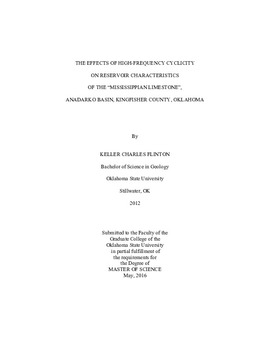| dc.contributor.advisor | Grammer, G. M. | |
| dc.contributor.author | Flinton, Keller Charles | |
| dc.date.accessioned | 2017-02-22T22:14:25Z | |
| dc.date.available | 2017-02-22T22:14:25Z | |
| dc.date.issued | 2016-05-01 | |
| dc.identifier.uri | https://hdl.handle.net/11244/49072 | |
| dc.description.abstract | Mississippian-aged limestones along the northern edge of the Anadarko basin in north-central Oklahoma and southern Kansas store considerable amounts of hydrocarbons and have been exploited through vertical drilling for more than 50 years. A shift to horizontal exploitation in this unconventional resource play has not yielded consistent well performance due to a lack of understanding of the controlling factors responsible for production-scale reservoir distribution.The �Mississippian limestone� is characterized by a hierarchical stratigraphy of sequences (100s of meters thick), high-frequency sequences (10s of meters thick) and high-frequency cycles (few meters thick) caused by fluctuations in eustatic and relative sea level due in part to Milankovitch-band cyclicity. Detailed facies analysis using cored intervals of the �Mississippian limestone� suggests deposition occurred along a distally-steepened mixed carbonate-siliciclastic ramp. The vertical stacking patterns of depositional facies defines high-frequency sequences and cycles (probable 4th and 5th-Order) within a shoaling-upward succession. From base to top within an ideal sequence, the shoaling-upward succession of facies consists of argillaceous and calcareous and slightly burrowed mudstones and wackestones followed by progressively higher-energy environments of deposition indicated by traction-laminated and more heavily bioturbated wackestones, packstones and grainstones. Incomplete development of this ideal vertical succession marked by a landward shift in facies belts established stacking patterns of hierarchical sea level cyclicity. High-frequency, Milankovitch-band sea level cyclicity ultimately controls the fundamental flow units of production-scale hydrocarbon reservoirs. Reservoir development is a function of the primary depositional facies and the sequence stratigraphic hierarchy. The primary reservoir is controlled by exposure associated with 3rd-Order regression and is vertically compartmentalized by 4th & 5th-Order high-frequency flooding surfaces. The abundance of detrital sedimentation is thought to improve the quality of secondary reservoir development. Guard resistivity curves are most useful at extrapolating the cyclostratigraphy throughout the subsurface. The core-defined, high-frequency sequence stratigraphy improves production-scale predictability of hydrocarbon reservoirs of the �Mississippian limestone�. | |
| dc.format | application/pdf | |
| dc.language | en_US | |
| dc.rights | Copyright is held by the author who has granted the Oklahoma State University Library the non-exclusive right to share this material in its institutional repository. Contact Digital Library Services at lib-dls@okstate.edu or 405-744-9161 for the permission policy on the use, reproduction or distribution of this material. | |
| dc.title | Effects of High-frequency Cyclicity on Reservoir Characteristics of the "mississippian Limestone", Anadarko Basin, Kingfisher County, Oklahoma | |
| dc.contributor.committeeMember | Puckette, Jim | |
| dc.contributor.committeeMember | Pethoud, Doug E. | |
| dc.contributor.committeeMember | Gregg, Jay M. | |
| osu.filename | Flinton_okstate_0664M_14518.pdf | |
| osu.accesstype | Open Access | |
| dc.description.department | Geology | |
| dc.type.genre | Thesis | |
| dc.type.material | text | |
